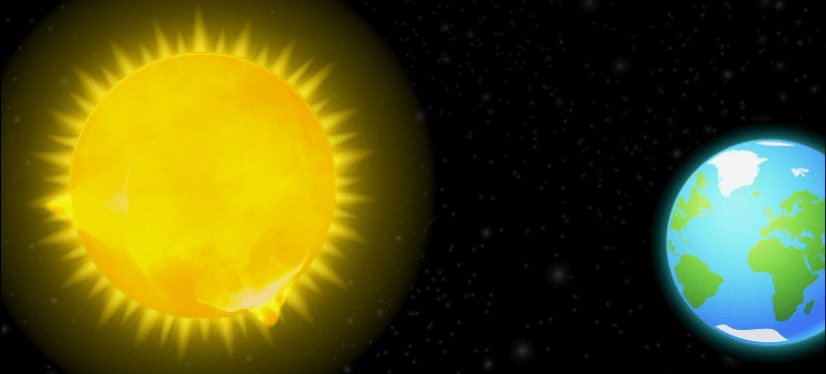
The National Aeronautics and Space Administration (NASA) had revealed recently that a solar storm could hit the Earth’s atmosphere soon, which would then trigger strong auroras in the northern poles. For those who aren’t already aware, solar storms (also called geomagnetic storms) are caused when large jets of highly charged particles emerge from the surface of the sun and get pushed out into space. Let’s begin by explaining what solar or geomagnetic storms actually are and what effects they can have on Earth.
According to a universally accepted definition, a solar storm is a term used for atmospheric effects felt on Earth as a result of certain events that occur on the Sun. You would probably think of the Sun as a bright shining ball of light that never changes. However, in reality, it is an unbelievably huge ball of molten gases that is constantly in flux.
Solar storms occur when the Sun emits massive bursts of energy in the form of solar flares and coronal mass ejections (A coronal mass ejection is a significant release of plasma and accompanying magnetic field from the Sun’s corona into the solar wind. CMEs are often associated with solar flares and other forms of solar activity). These are capable of sending a stream of electrical charges and magnetic fields toward the Earth at a speed of about three million miles per hour.
When a solar storm strikes the Earth’s atmosphere, it often produces dazzling lights displayed in parts of the atmosphere that can then be seen in areas close to the Arctic Circle (called Aurora Borealis) and the Antarctic Circle (Aurora Australis). However, these storms can have a significant impact on satellites and various forms of electronic communications, by disrupting them, sometimes even completely.
In 1859, the world was hit by a massive geomagnetic storm, now known as the Carrington Event and that led to telegraph systems across the globe failing catastrophically. Imagine what could have happened now! In September 1859, when the storm hit, the operators of the telegraphs reported receiving electrical shocks, telegraph paper catching fire, and being able to operate equipment with batteries disconnected. Something else happened too as a result of the catastrophic event. During the evenings, the Aurora Borealis, more commonly known as the Northern Lights, could be seen as far south as Colombia. Typically, they are only visible at higher latitudes, in northern Canada, Scandinavia and Siberia.
In this day and age, a geomagnetic or a solar storm of the same intensity as the Carrington Event would affect far more than just telegraph wires and could change the world as we know it. With humankind’s ever-growing dependency on electricity and emerging technology, any kind of disruption could lead to trillions of dollars of monetary loss and risks to life that are dependent on the systems. A geomagnetic storm of such a large scale would quite easily affect a majority of the electrical systems that people use on a daily basis.
A more drastic impact would be on communication systems across the world, in addition to electric failures. Your beloved Wi-Fi, hotspots, and internet service providers could go down completely, taking out the ability of different systems to communicate with each other. High-frequency communication systems such as ground-to-air, shortwave and ship-to-shore radio would also be disrupted. Satellites in orbit around Earth could be damaged to a large extent by induced currents from the geomagnetic storm burning out their circuit boards. This would also lead to disruptions in satellite-based telephone, internet, radio and television systems.
One other area of disruption that would potentially affect one’s everyday life is navigation systems. Every mode of transportation, from cars to aeroplanes, uses GPS for navigation and tracking. Your mobile phones, smartwatches and tracking tags rely heavily on GPS signals sent from satellites and if that is disrupted, these systems could stop functioning. Even the world’s military systems are heavily dependent on GPS for coordination. Other military detection systems such as over-the-horizon radar and submarine detection systems could be disrupted, which would then hamper national defence.
Imagine a world without national defence, navigation, cell phones, internet connection and electricity, will humankind survive? Well, if and when such a storm occurs, we should start preparing for them now. With continued research, we could find ways to protect these integral systems and hence not be taken by surprise if or when such a catastrophic event occurs. In short, we can’t prevent it but at least minimise the effect of a geomagnetic or solar storm when it arrives.
Could you live without the internet and electricity for days? Tell us in the comments below.
Enjoyed reading this? Then check out more stuff on The Learning Tree blog:
Scientists May Have Found the Source of Earth’s Water
Writing has always been Shreesha’s passion, be it for imparting knowledge or expressing opinions. In her former role as a journalist, she contributed to enriching society with knowledge. Now, at BYJU’S, she has moved on to something more exciting – creating tailor-made content for students. When she is not writing, you would find her looking for new ways to engage her child.